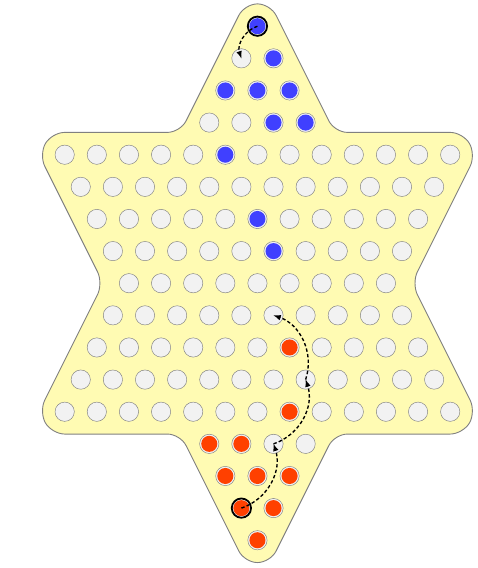We use a \foreach loop that takes the number of positions in each row as the loop list. For the standard chinese checkers boards, that could look like \foreach \m [count=\count] in {1,…,4,13,12,…,9,10,11,…,13,4,3,…,1}.
If you systematically name the nodes you create in this loop, you’ve got a very nice framework for drawing Chinese Checkers setups and moves. I’ve written a couple of macros and styles for this.
The command \checkerboard[checkerboard labels] will draw a blank board with the fields labeled
We can then place pieces using
\placepieces[
and show moves using
\showmove{
\documentclass[tikz,border=10pt]{standalone}
\usetikzlibrary{backgrounds,decorations}
\begin{document}
\begin{tikzpicture}
\newif\ifcheckerboardlabels
\tikzset{
pieces/.style={
fill,
circle,
minimum size=0.5cm
},
positions/.style={
fill=black!5, draw=gray,
solid,
circle,
minimum size=0.6cm,
inner sep=0pt,
},
checkerboard labels/.is if=checkerboardlabels,
checkerboard labels/.default=true,
move/.style={
-latex,
densely dashed,
very thick,
bend right=45
}
}
\newcommand{\checkerboard}[1][]{
\begin{scope}[#1]
\foreach \m [count=\count] in {1,...,4,13,12,...,9,10,11,...,13,4,3,...,1}{
\foreach \n in {1,...,\m}
\node at (\n-\m/2,\count) [
positions,
name=pos-\count-\n,
outer sep=0.5cm,
label=center:{\ifcheckerboardlabels \count-\n\fi}] {};
}
\begin{pgfonlayer}{background}
\draw [gray,thick,rounded corners=0.4cm,fill=yellow!30] (pos-1-1.240) -- (pos-5-5.240) -- (pos-5-1.240) --
(pos-5-1.180) -- (pos-9-1.180) -- (pos-13-1.180) --
(pos-13-1.120) -- (pos-13-5.120) -- (pos-17-1.120) --
(pos-17-1.60) -- (pos-13-9.60) -- (pos-13-13.60) --
(pos-13-13.0) -- (pos-9-9.0) -- (pos-5-13.0) --
(pos-5-13.300) -- (pos-5-9.300) -- (pos-1-1.300) -- cycle;
\end{pgfonlayer}
\end{scope}
}
\newcommand{\placepieces}[2][]{
\begin{scope}[#1]
\foreach \checker in {#2} {
\node [pieces,#1] at (pos-\checker) {};
}
\end{scope}
}
\newcommand{\showmove}[2][]{
\begin{scope}[#1]
\foreach \position [remember = \position as \previousposition,count=\count] in {#2}{
\ifnum \count=1
\node at (pos-\position.center) [positions,black,ultra thick,fill=none] {};
\else
\draw [move] (pos-\previousposition.center) to (pos-\position.center);
\fi
}
;
\end{scope}
}
\checkerboard
\placepieces[red!75!yellow]{1-1,2-1,2-2,3-1,3-2,3-3,4-1,4-2,5-8,7-7}
\placepieces[blue!75]{17-1,16-2,15-1,15-2,15-3,14-3,14-4,13-6,11-6,10-6}
\showmove{2-1,4-3,6-8,8-6}
\showmove{17-1,16-1}
\end{tikzpicture}
\end{document}
